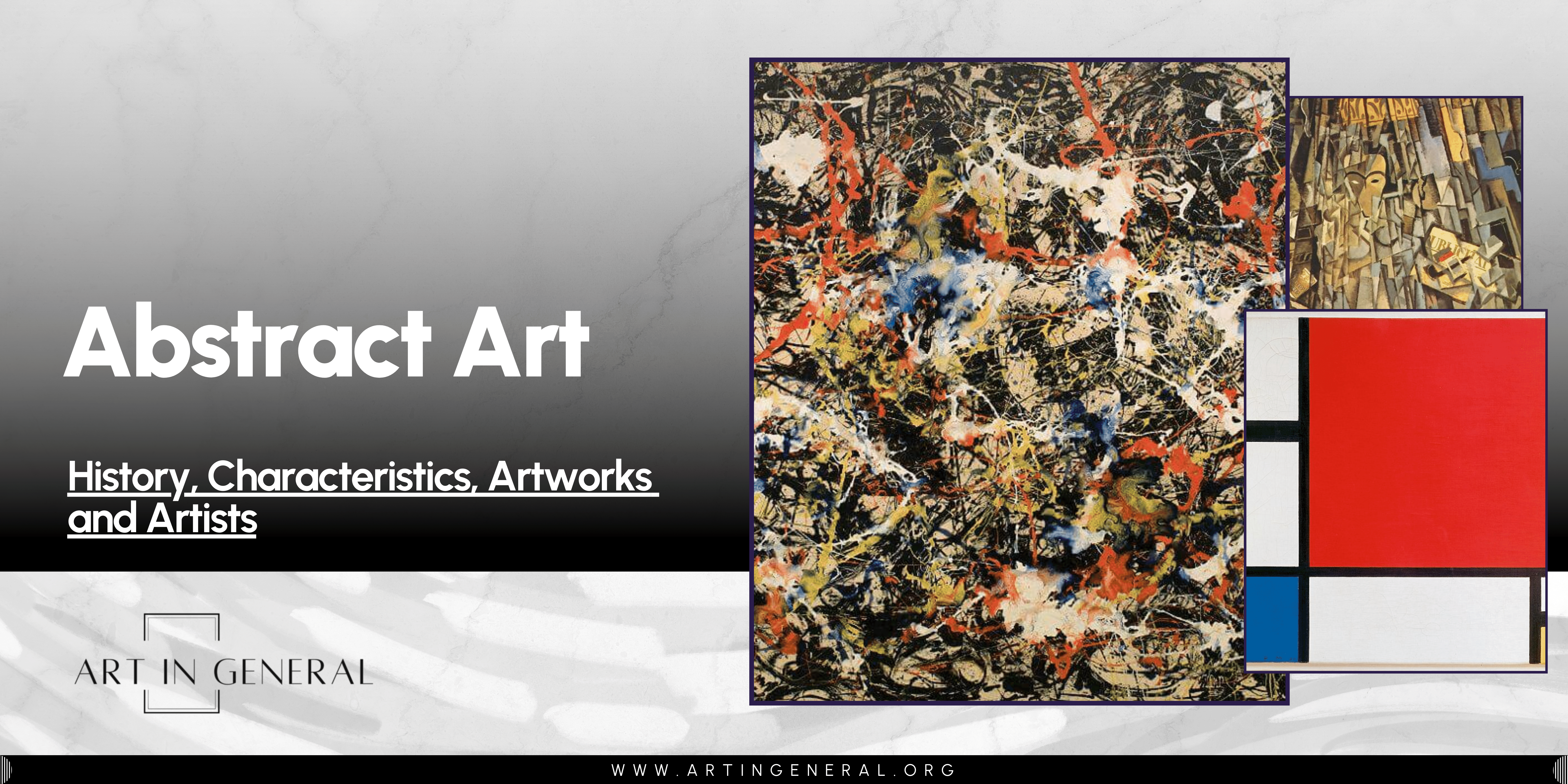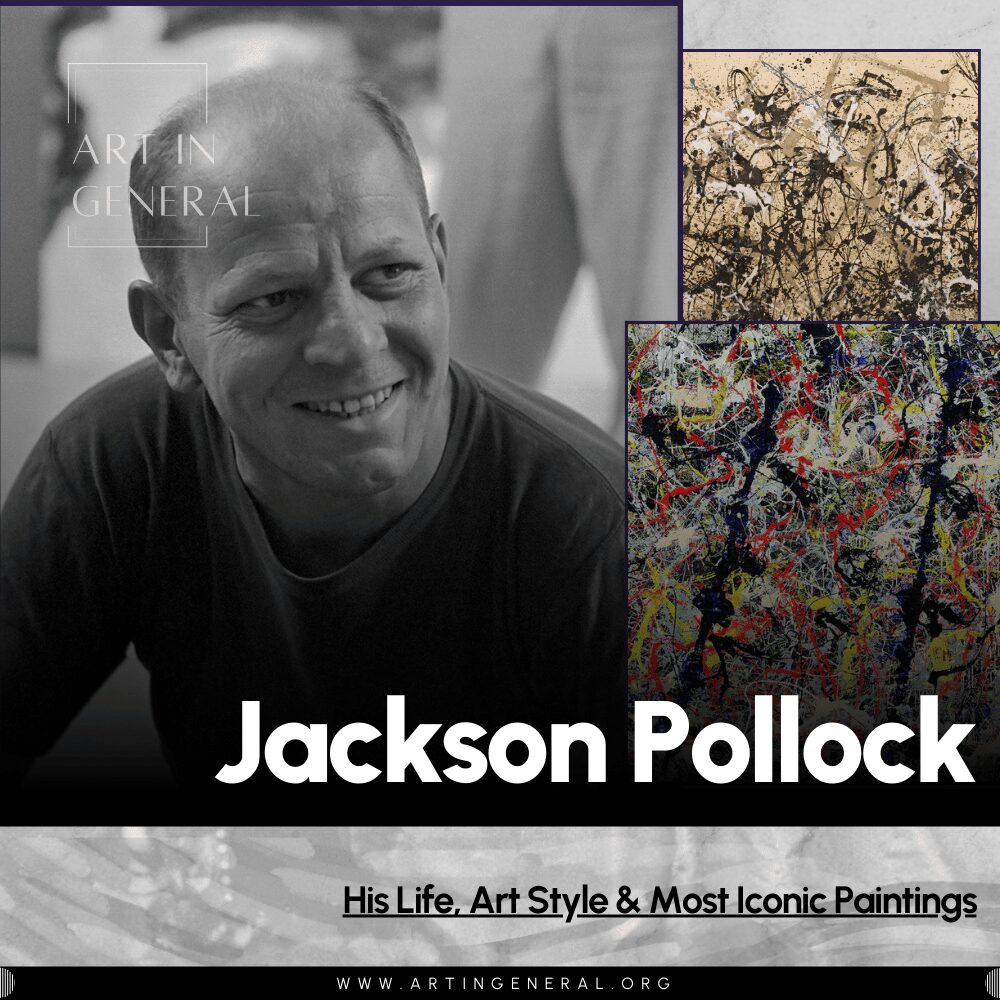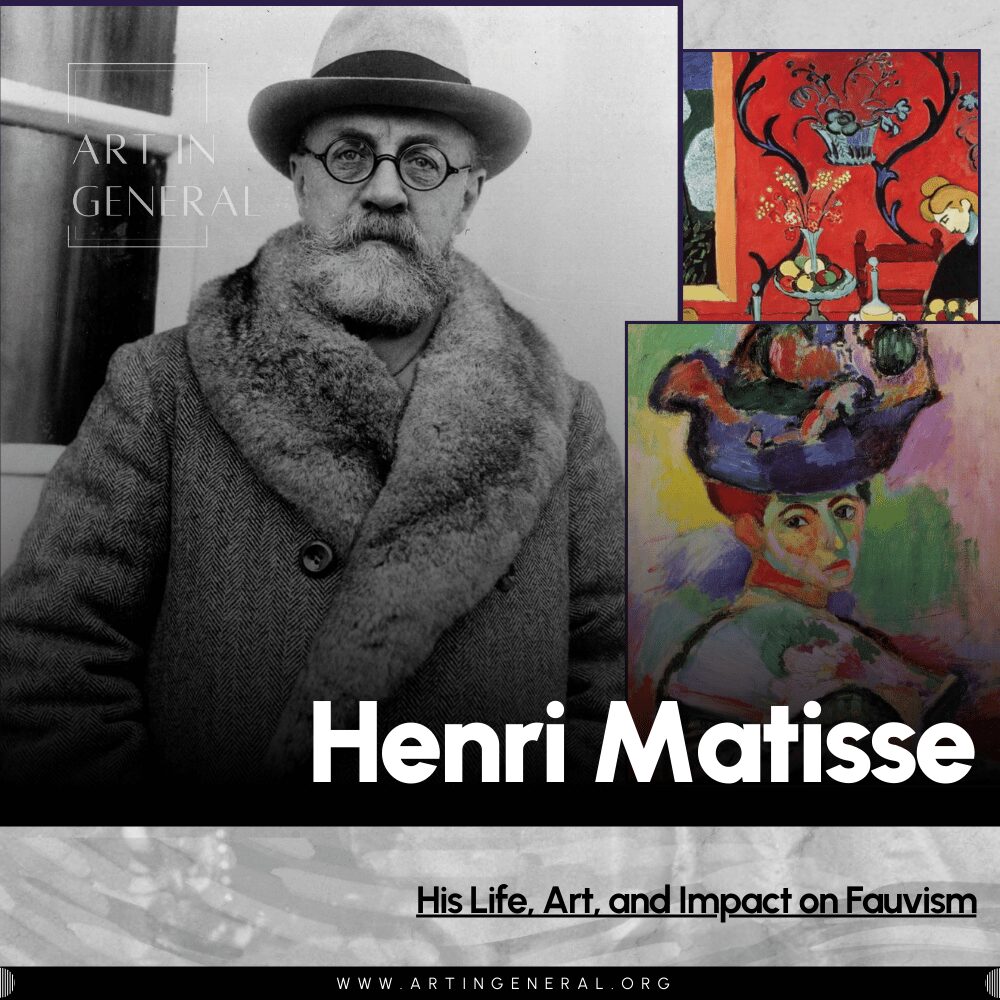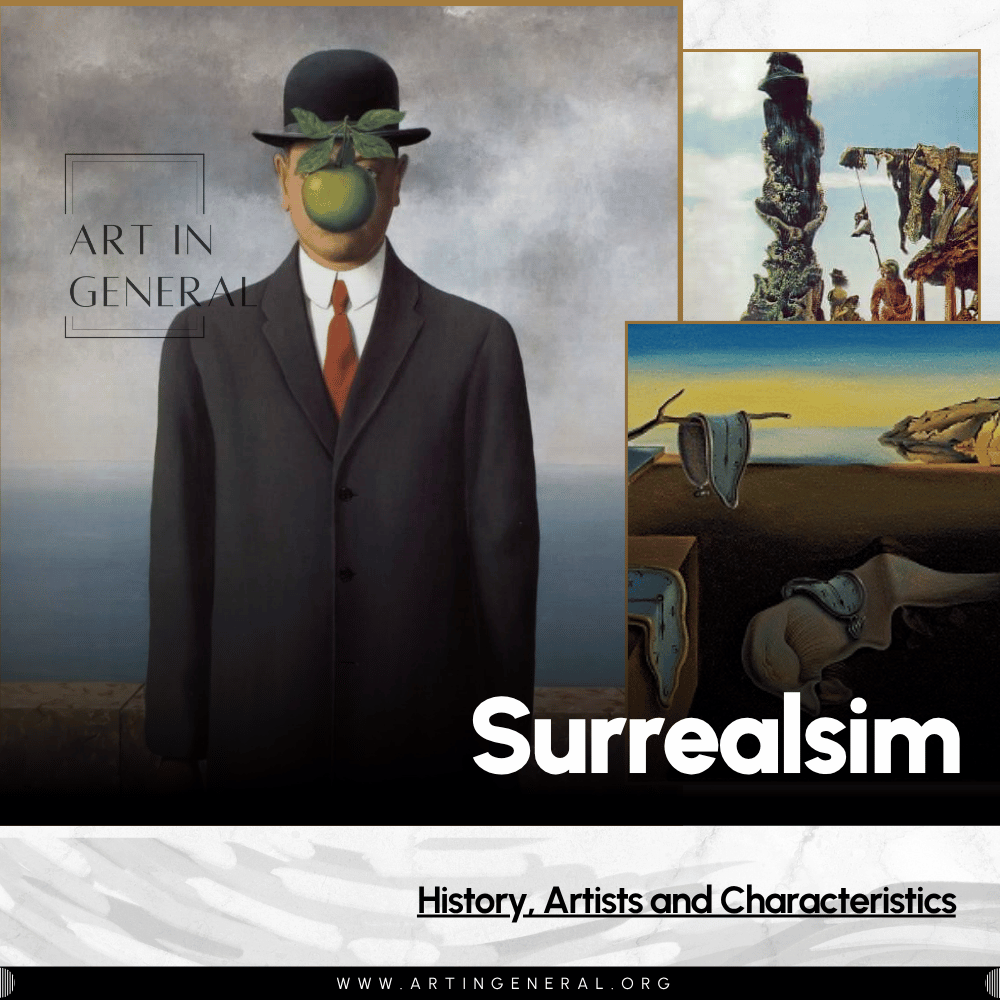
Abstract art employs shapes, forms, colors, and gestural strokes to create its impression rather than attempting to provide a precise representation of a visual reality. Abstract painters employ a unique visual language of colors, forms, and marks to convey feelings, concepts, and experiences. The methods and materials used to create abstract art become considerably more significant, with less emphasis on the piece’s subject matter. The artist’s objective can be effectively communicated through texture, depth, and color.
Abstraction has been a part of culture and history since its inception in the late 19th century. Wassily Kandinsky was the first modern artist to deal with non-representational shapes. In 1910, he abandoned the conventions of figurative painting to create his first abstract watercolor, which remained nameless. He was influenced by a haystack picture by Claude Monet, who showed him that form and color could have just as much impact as clarity and presence in a painting.
Abstract art can be labeled in many ways today and remains within the broad category due to its versatility, allowing for its tremendous evolution. Genres including Abstract Expressionism, Color Field, Post-Painterly Abstraction, Lyrical Abstraction, and Minimalism fall under this category. Abstract art has also permeated contemporary art and continues to attract a high price in commercial galleries and auction houses.
The Birth of Abstract Art: Historical Context
The invention of photography in the early 1800s was a pivotal moment in the history of modern abstract art. For the first time, those who owned a camera gained the capacity to record the observable world. The role of art underwent a permanent transformation; artists ceased to be just guardians of truth and instead became adventurers, unrestricted in their exploration of uncharted territories of form and color.
J.M.W Turner’s artworks transformed landscapes and seascapes into abstract representations of nature. Claude Monet and the Impressionists defied traditional academic painting by focusing on capturing the nuances of light and atmosphere. Pablo Picasso and Georges Braque dismantled the concept of reality by incorporating various perspectives into a single Cubist artwork. Cubism and Fauvism were the artistic movements that directly introduced abstraction. Cubism was founded on Cézanne’s concept that all representations of nature could be reduced to cubes, spheres, and cones.
Beginning of Abstract art
The onset of the 20th Century ushered in numerous new advancements, conflicts, and progressive ideologies that necessitated a distinct artistic reaction. Artists such as Picasso, Cezanne, and Matisse already employed unconventional methods, but the Russian artist Wassily Kandinsky is recognized for pioneering Abstraction. In 1911, he published “On the Spiritual in Art,” a book still regarded as a fundamental text in abstract art. Hilma af Klint may have created the first abstract painting in 1906, as some claim, but the public noticed her work much later.
Development of Abstract art
The appeal for freedom in abstraction, along with the tragedies of World War I and the advent of the mechanical age, gave rise to an array of new abstract techniques. Cubism encouraged artists to distill their visual language down to its most fundamental components.
- In the 1920s, Piet Mondrian incorporated geometric elements. Futurism illustrated the line’s strength and vigor. Dadaism questioned what art was and reaffirmed its independence from and rejection of the bourgeois. Artists were first introduced to the potential of the subconscious through surrealism. In order to produce his frenzied, intense markings, Cy Twombly went back to surrealism automatism, repressing his conscious control and giving the unconscious mind considerable influence.
- The 1940s and 1950s saw the rise of Abstract Expressionism as the new wave of abstract painters in America. Jackson Pollock gained recognition for inventing drip or action painting on a horizontal canvas, which allowed him to view his artwork from every angle and create from them. Pollock and the other prominent figures of Abstract Expressionism—Franz Kline, Willem de Kooning, and Arshile Gorky—convened at the Cedar Tavern in downtown Manhattan every night to deliberate upon the new methodology of abstraction.
- The second phase of Abstract Expressionism emerged in the 1950s, replacing riotous gestures with an emphasis on the expressive power of color. The method developed by Helen Frankenthaler, known as soak-stain, involved pouring paint onto unprimed canvas. This process served as the cornerstone for a subsequent generation of Color Field painters, such as Sam Gilliam, Kenneth Noland, and Mark Rothko. Together, they created astounding fields of color that harmoniously blended the figure and the ground. Rothko’s paintings might move viewers to tears because they engulfed them in such a powerful experience with color.
- In the 1960s and 1970s, an orderly and pure abstract minimalist art movement influenced by Malevich’s teachings began to materialize. Agnes Martin, Carl Andre, Dan Flavin, Donald Judd, and Frank Stella all believed that art distinguished itself from others by embodying its reality. Judd’s rectilinear constructions, Flavin’s neon pieces, and Andre’s arrangement of bricks are some of the most well-known examples of abstract art from this era.
End/Legacy of the Movement
Abstract art has undergone further transformations since the turn of the 21st century. Artists like Albert Oehlen and Christopher Wool deconstruct the conventions of abstract art and enthusiastically use innovative technologies to push the limits of what a painting can include. Abstract artists will persistently explore the profound depths of emotion and experience that exist beyond the realm of what is seen.
Socio-political Influences on Abstract Art
The socio-political environment of the late 19th and early 20th centuries had a significant impact on the development of abstract art. In the wake of two World Wars, fast industrialization, urbanization, and other social upheavals, artists looked for fresh ways to convey the intricacies of contemporary life. The emergence of ideas such as existentialism, Marxism, and Freudian psychology upended conventional wisdom and promoted a move toward abstraction as a way to reject rules and embrace autonomy.
Technological Advancements and Abstract Art
Digital media, photography, and film have greatly influenced abstract art styles. Photography gave artists the opportunity to explore novel viewpoints, question conventional depictions, and open the door for abstraction’s focus on form, color, and texture. With the development of film came the ideas of motion and sequential imagery, which encouraged artists to play around with dynamic compositions and non-linear storytelling. The production and distribution of abstract art have been completely transformed in the digital age by software tools and digital platforms, which give artists unmatched freedom to work with algorithms, alter images, and collaborate over great distances.
Defining Characteristics of Abstract Art
An abstract art is distinguished by its deviation from representational art forms and the utilization of non-representational components to communicate significance. Abstract art is characterized by several essential features:
Non-representational
Abstract art makes no effort to capture the real world perfectly. Instead, it employs colors, forms, shapes, lines, and textures to elicit emotions and thoughts.
Expressive
An abstract painting is characterized by its high level of expressiveness, frequently prioritizing the conveyance of emotion rather than the depiction of objects or figures. Artists utilize the vocabulary of color, shape, and texture to construct a visual language that effectively communicates their emotional and intellectual reactions to the world.
Non-objective
Abstract art is sometimes known as “non-objective” art since it does not depict any tangible things or figures. Instead, it is solely developed for its intrinsic value, serving as an investigation of form and color.
Gesture
Abstract art frequently highlights the gesture and motion of the artist’s hand during the creation of the artwork. Artists employ various techniques such as brushstrokes and drips to provide a perception of motion and vitality in their artwork.
Revolutionizing Art through Abstraction
Abstract art transformed the utilization of form, color, and composition by freeing artists from the limitations of depicting identifiable objects. Abstract painters deviated from conventional representational art by focusing on pure form, brilliant color, and dynamic composition to elicit emotions, ideas, and feelings. Artists began to explore the fluidity and subjectivity of form and composition, experimenting with geometric shapes, gestural lines, and organic forms. Color acquired a new significance as a method of communication, separated from its role of representing objects and employed to communicate mood, vitality, and rhythm.
Pioneers and Icons of Abstract Art
The pioneers of Abstract art include, Wassily Kandinsky, Piet Mondrian, Mark Roth and Kazimir Malevich.
Wassily Kandisky

- Born: 16 December 1866, Moscow, Russian Empire
- Died: 13 December 1944 (aged 77) Neuilly-sur-Seine, France
- Nationality: Russian, later French
- Education: Academy of Fine Arts, Munich
- Most Known works:
- On White II
- Der Blaue Reiter
- Composition series
Wassily Kandinsky was a major influence on the evolution of 20th-century painting, especially in non-objective and non-representational art. He gradually eschewed depicting well-known subjects in favor of experimenting with pure form and color. He produced dynamic compositions that exuded a sense of motion, energy, and feeling by combining geometric shapes, bold lines, and brilliant colors.
Kandinsky’s interest in spirituality, especially theosophy and the concept of synesthesia—the combining of diverse senses—strongly influenced his abstract style. He felt that a viewer’s emotions and spiritual experiences could be evoked by art, and he used color and form to create a sense of transcendence and harmony. He aimed to develop an all-encompassing visual language that, unrestricted by identifiable forms, could directly speak to the viewer’s spirit. He thought that the ability of pure abstraction to transcend linguistic and cultural barriers would enable direct and intuitive contact between the artist and the audience.
Piet Mondrian

- Born: 7 March 1872 Amersfoort, Netherlands
- Died: 1 February 1944 (aged 71), New York City, U.S.
- Education: Rijksakademie (Academy of Fine Arts), Amsterdam
- Most Known works:
- Evening; Red Tree, Gray Tree
- Composition with Red Blue and Yellow
- Broadway Boogie Woogie
Piet Mondrian is renowned as a trailblazer in 20th-century abstract art. He underwent a significant artistic transformation, shifting from realistic painting to a progressively abstract approach. Eventually, he arrived at a stage where his artistic expression was distilled to basic geometric principles.
Piet Mondrian’s artwork exerted a significant influence on the advancement of modern abstract art. Mondrian’s distinctive method of creating abstract paintings was influenced by his fascination with spiritualism and his conviction in the interconnectedness of the cosmos. He aimed to establish a comprehensive visual system that effectively conveys the fundamental laws of nature and the universe.
Mark Rothko’s

- Born: September 25, 1903 Dvinsk, Russian Empire (now Daugavpils, Latvia)
- Died: February 25, 1970 (aged 66) New York City, U.S.
- Nationality: American
- Education: Yale University
- Most known arts:
- Violet, Black, Orange, Yellow on White and Red, 1949
- Black on Maroon, 1959
Mark Rothko’s artistic methodology centered on the investigation of color, form, and space in order to provide the viewer with a profoundly sentimental and reflective encounter. His method was applying light coats of paint layer upon layer to produce bright, luminescent surfaces. His paintings were painstakingly created, with expansive, rectangular color fields that seemed to hover on the canvas. It was frequently difficult to distinguish between figure and ground because of the softening or blurring of these fields’ borders. His use of color was incredibly intricate and delicate; little changes in tone and hue gave the picture a sense of depth and movement. Rothko thought that the observer may experience a sense of transcendence and emotional release from his paintings, leading to a transforming experience.
Masterpieces of Abstract Art
Some of the major masterpieces of Abstract art are On White II, Composition II in Red, Blue, and Yellow, Convergence, and White Center (Yellow, Pink and Lavender on Rose)
On White II

Artist: Wassily Kandinsky
Year: 1923
Medium: oil on canvas
Dimensions: 105 cm × 98 cm (41 in × 39 in)
Location: Musée National d’Art Moderne, Paris
On White II demonstrates a sophisticated fusion of the primary colors used in the artwork, which are black and white. Kandinsky employed color to symbolize elements beyond just forms and figures in his artworks. This painting employs several shades of the color white to represent the numerous potentialities and prospects that exist in life. In contrast, the color black symbolizes absence and mortality. Kandinsky depicted the color black as a representation of deathly silence. In this painting, the black hue forcefully pierces through the white background, disrupting the tranquility of the vibrant array of colors, symbolizing the various possibilities in life.
Composition II in Red, Blue, and Yellow

Artist: Piet Mondrian
Date: 1930
Medium: Oil on Canvas
Dimensions: 46 x 46 cm
Location: Kunsthaus Zürich
Composition II in Red, Blue, & Yellow is distinguished by its utilization of primary colors (red, yellow, and blue) and achromatic colors (black, gray, and white), along with geometric forms, specifically rectangles. Mondrian aimed to achieve artistic purity by utilizing fundamental components like color and geometric shape, resulting in a harmonious and balanced composition.
Piet Mondrian’s artwork made a substantial impact on the advancement of abstract art, and his investigation of primary colors and geometric abstraction remains relevant in the realm of art and design. The artist’s aesthetic, distinguished by the use of grids, rectangles, and primary colors, has been extensively embraced and modified in diverse manifestations of modern art.
Convergence

Artist: Jackson Pollock
Year: 1952
Medium: Oil on canvas
Dimensions: 237 cm × 390 cm (93.5 in × 155 in)
Location: Buffalo AKG Art Museum, Buffalo
Convergence is a composition of vibrant colors scattered over a canvas, forming intricate forms and lines that elicit strong emotions and captivate the viewer’s attention. Pollock skillfully utilized colors, textures, lines, lighting, and contrasting forms in his brushstrokes. The artist’s feelings are inadvertently conveyed through these lines, dots, and circles. The painting was created during the Cold War with the Soviet Union, and it is widely believed that the artwork symbolizes the concept of freedom of expression.
White Center (Yellow, Pink and Lavender on Rose)

Artist: Mark Rothko
Year: 1950
Dimensions: 205.8 cm × 141 cm (81.0 in × 56 in)
Location: The Royal family of Qatar
White Center (Yellow, Pink, and Lavender on Rose) exemplifies Rothko’s unique multiform technique, featuring multiple blocks of layered, complementary hues on a sizable canvas. The painting represents Rothko’s multiform technique of abstract painting from top to bottom. A rose-colored surface, exhibiting a darker shade on the upper portion and a lighter shade on the lower portion, contains a horizontal yellow rectangle, which is then succeeded by a black horizontal strip. The picture features a white rectangular band positioned at the center, while the lower portion is colored in lavender. Multiple shades of colors were employed, creating a diverse array of emotions and ambiance.
Meaning of Iconic Abstract Artworks
Artworks in the Abstract art movement achieve iconic significance by boldly deviating from representational forms and instead emphasizing the investigation of color, shape, and form to elicit emotional and intellectual reactions. These artworks frequently defy conventional ideas about art and invite viewers to interact with the fundamental essence of visual representation.
Abstract Art Compared to Other Movements
Abstract Art vs. Figurative Art
Abstract art encompasses artworks that eschew the representation of identifiable reality and instead employ shapes, colors, forms, and textures to produce their desired impact. Abstraction in art refers to the deviation from reality in the representation of imagery. Notable figures in the development of abstract art throughout the early 20th century include Wassily Kandinsky, Piet Mondrian, and Kazimir Malevich.
Figurative art, commonly referred to as representational art, is an artistic style that portrays tangible objects, individuals, or landscapes from real life. During the Renaissance period, figurative art had significant advancements in refinement. Renowned artists such as Michelangelo and Leonardo da Vinci created very realistic portraits and sculptures.
Abstract and figurative painting both get inspiration from the same realm, seeking to accurately depict the strength, delicate tensions, and nuanced emotions that truly portray a particular state, subject, or theme. In modern literature, the two forms are frequently fused, blending and converging as the distinctions between them grow increasingly blurred.
Abstract Art vs. Realism
Realism is a genre of visual art that aims to accurately depict the natural world with a high degree of accuracy. This frequently involves generating a visual perception of depth and three-dimensionality while also faithfully replicating the textures, colors, and lighting found in the physical environment. Realism emerged in France around the mid-19th century, with a strong emphasis on painters representing the surrounding reality with utmost precision and accuracy.
Abstract art, originating in the early 20th century, employs diverse imagery and visual representations with the primary objective of portraying reality in a novel manner that resonates more profoundly with the human psyche, emotions, and spirituality—the primary distinctions between Realism and Abstract art lie in their respective approaches to representation. Realism aims to faithfully depict the natural world as it is viewed, while Abstract art deliberately eschews any concrete composition and distances itself from the subject matter.
Abstract Art vs. Abstract Expressionism
Abstract Expressionism is a phrase used to describe American painters who were creating abstract works of art during the 1940s and 1950s. The initial phase of the movement in the United States is distinguished by its refusal to adhere to conventional artistic norms and its emphasis on spontaneity and physical expression.
Similar to other forms of art, both abstract and abstract expressionist artworks aim to evoke a strong emotional response in the audience by deliberate decisions about color, composition, and other artistic elements. Abstract Expressionism emerged as a willful rejection of the preceding Impressionist movement, which aimed to portray realistic scenes. However, it also served as a prelude to the subsequent wave of abstract art.
Abstract art rejects representational forms and instead employs non-referential shapes, lines, and color schemes. Unlike abstract Expressionism, which may still have figurative elements, this approach does not altogether reject them.
Abstract Art vs. Surrealism
Surrealism, originating in Paris in 1924, is an artistic movement that draws inspiration from the unconscious mind and interprets subjects through the lens of the unconscious. Surrealists claim that artistic inspiration originates from the unconscious psyche. Abstract art and Surrealism emerged as a result of artists’ quest for novel and improved means of self-expression, driven in part by their discontent with the prevailing norms and conventions of their era. Abstract and Surrealism emerged as innovative means for artists to manifest their creative expression.
Abstract and Surrealism emerged from disparate concepts and diverse influences. Each of them was initially employed in a distinct artistic media; however, their most prominent manifestation nowadays is in the realm of paintings. Furthermore, they vary in the particular standard or concept that they are refusing or deviating from. While every artwork might be perceived as originating from the artist’s mind, each artistic style also possesses distinct ideas and objectives.
The Legacy of Abstract Art
Abstract art had a significant impact on post-war America, leading to a common understanding of other artists and movements in relation to it. During the early 1950s, Ad Reinhardt and, subsequently, Frank Stella created abstract paintings, but they consciously distanced themselves from the Abstract Expressionist movement by rejecting the emphasis on gestural brushwork. Instead, they strengthened the fundamental nature of the painting as a tangible entity by employing precise geometric shapes and applying paint smoothly, foreshadowing the emergence of Minimalism in art. After a few decades, Abstract Art experienced a period of relative obscurity before being revived and existing alongside a diverse range of art forms and ideas, which is characteristic of our postmodern reality.





Leave a Reply